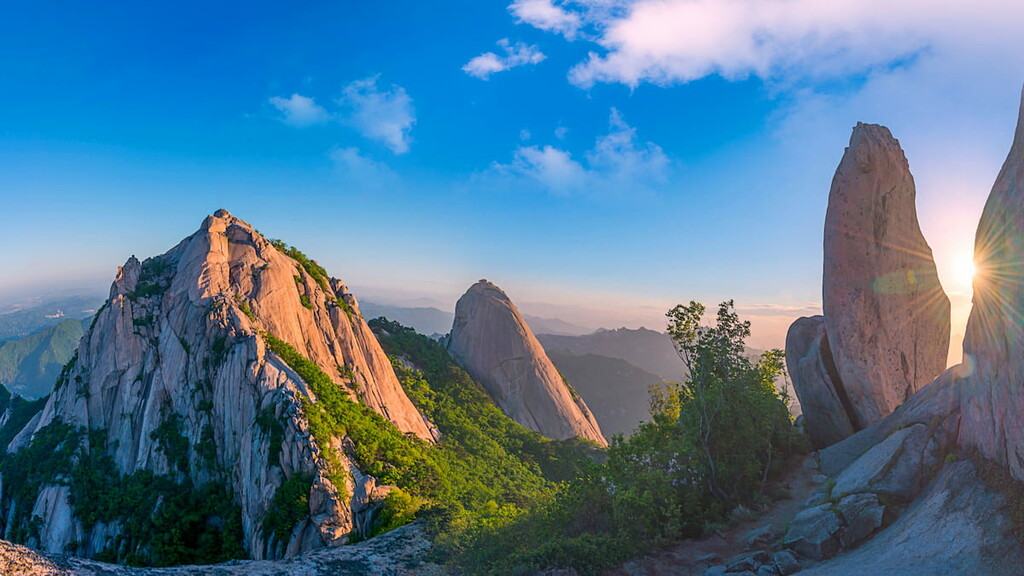Get PeakVisor App
Sign In
Search by GPS coordinates
- Latitude
- ° ' ''
- Longitude
- ° ' ''
- Units of Length

Yes
Cancel
Share ×

Scan the QR code and open PeakVisor on your phone
❤ Wishlist ×
Choose
Delete
Nestled within the bustling cityscape of Seoul (서울특별시), the capital of South Korea, lies a natural haven of Bukhansan National Park (북한산국립공원). Of 54 named peaks, Bukhansan (835 m/2,740 ft) (북한산, also known as Baikundae) is the highest and most prominent mountain.
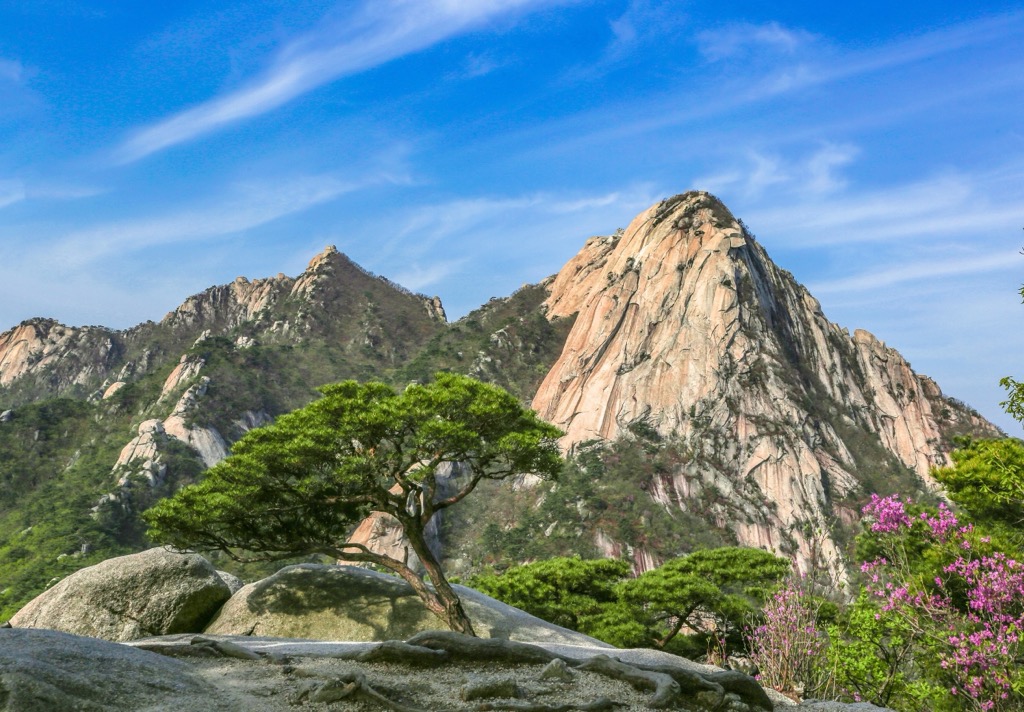
Encompassing 80 sq km (31 sq mi), Bukhansan National Park features granite peaks, forests, and ornate temples. This ecological gem is in the northern region of buzzing Seoul, entirely surrounded by urban expanse. The Korean translation of Bukhansan is ‘north of the Han River,’ which is Seoul’s primary north-south divide.
In a city of nearly 10 million, 5 million visitors frequent Bukhansan National Park annually. The accessibility of the park makes it a favorite hiking destination for city dwellers and passing travelers.
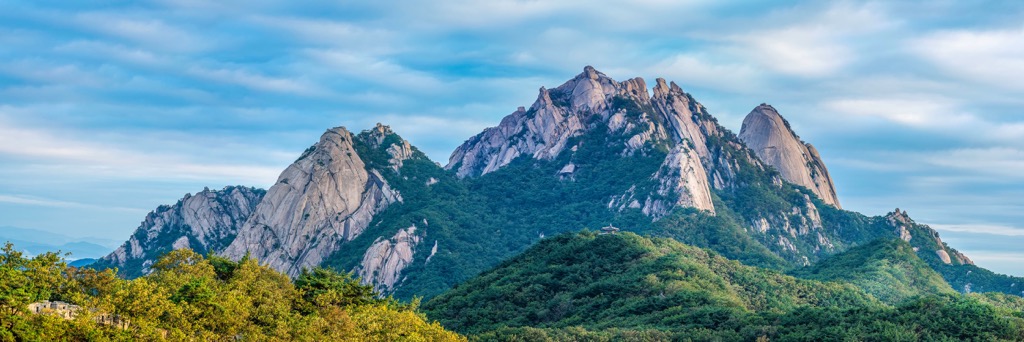
In fact, this well-regarded nature attraction is in the Guinness Book of Records as ‘The Most Visited National Park per Unit Area.’ However, due to its popularity, the park restricts trails on a rotating basis to protect the 1,300 species of flora and fauna.
Seoul and Bukhansan National Park experience a humid continental climate that nurtures the growth of temperate forests of both deciduous and conifers and temperate grasslands.
The park holds historical and cultural significance with ancient treasures, such as the 9th-century Wontongsa Temple and Bukhansanseong Fortress. Construction of the 9.5 km (6 mi) wall began during the middle Joseon period around the 1650s and wasn’t completed until 1711.
Jagged granite mountains are another feature of Bukhansan National Park. Besides Bukhansan, the tallest peaks include Insubong (인수봉), Mangyeongdae (만경대), and Yongambong (용암봉). Other hiking areas to explore in Seoul are Namsan Park (남산공원), Inwangsan Mountain (인왕산), and Naksan Park (낙산공원).
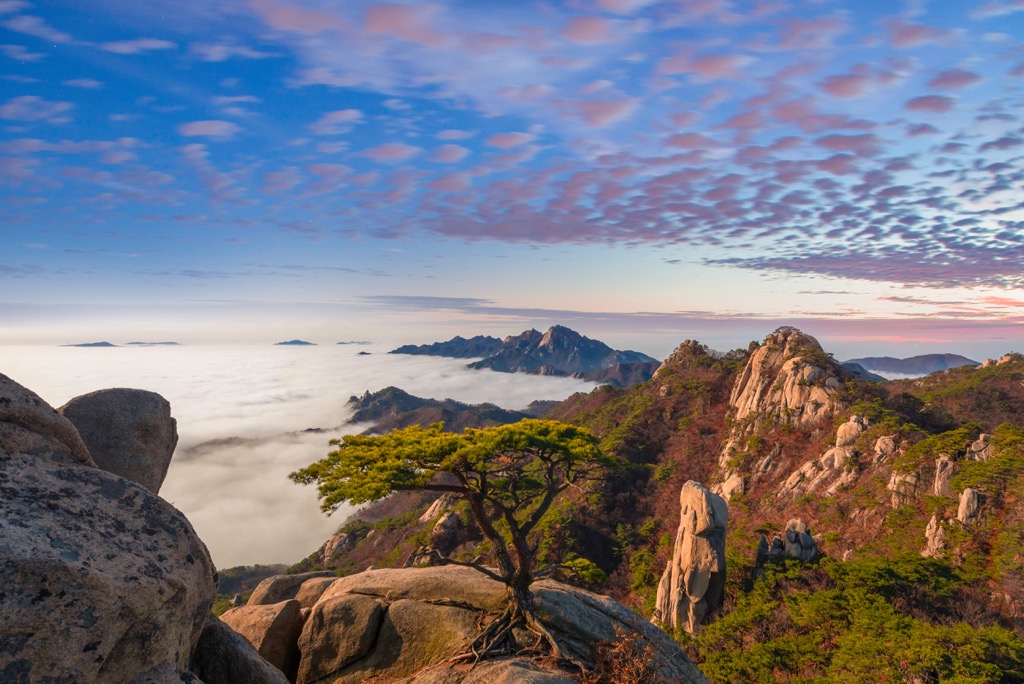
The mountains in Bukhansan National Park are part of the more extensive Bukhansan Mountain Range, which stretches across approximately 80 sq km (50 sq mi). The range is primarily composed of metamorphic and igneous rocks, showcasing a variety of geological formations. Granite is the primary rock strata; gneiss, schist, and marble are also present.
The park features a combination of deciduous and coniferous forests and diverse plant communities. Like other humid continental forests, notable tree species include oak, maple, and pine. Rhododendrons flourish during the springtime, and bamboo groves dot the landscape.
Wildlife species that inhabit Bukhansan National Park are water deer, wild boar, and the Korean goral. Chipmunks and squirrels are abundant. Bird species include woodpeckers, songbirds, and the Eurasian jay.
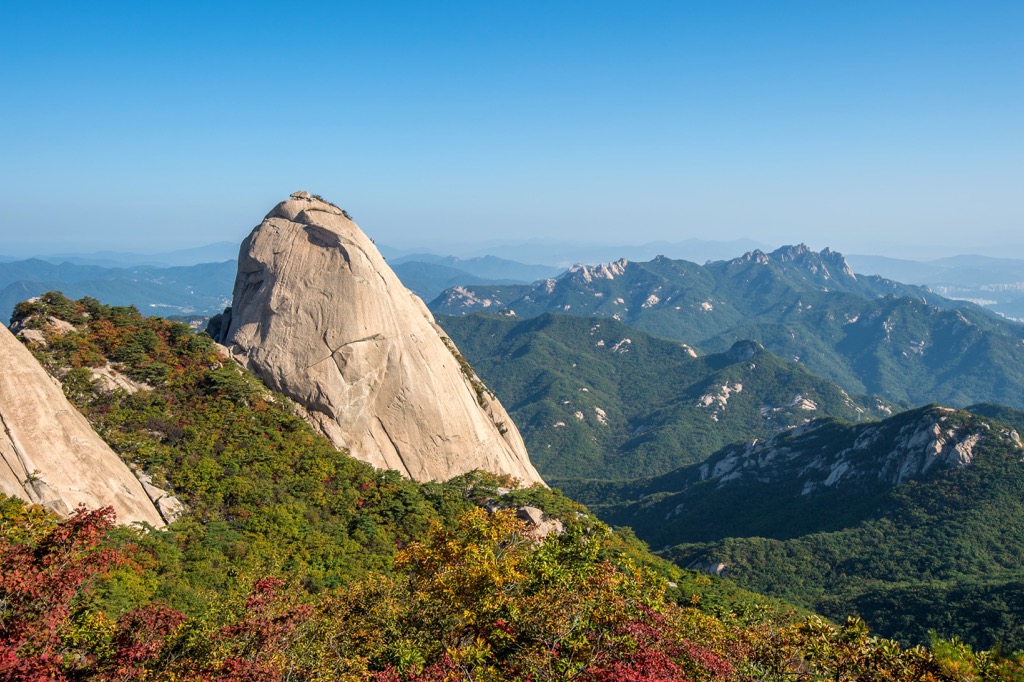
The origins of Bukhansan National Park can be traced back to the Joseon Dynasty (1392 to 1897), when the area was designated as a royal hunting ground for the nobility. During this period, the mountains served as a retreat for the royal family, who constructed many pavilions and temples.
The Royal Family initially constructed the Bukhansanseong Fortress to defend Seoul from attacks, but the 120-room residence became a royal retreat.
In 1983, recognizing the region's ecological value and cultural heritage, the South Korean government established Bukhansan National Park, making it the 15th national park in the country.
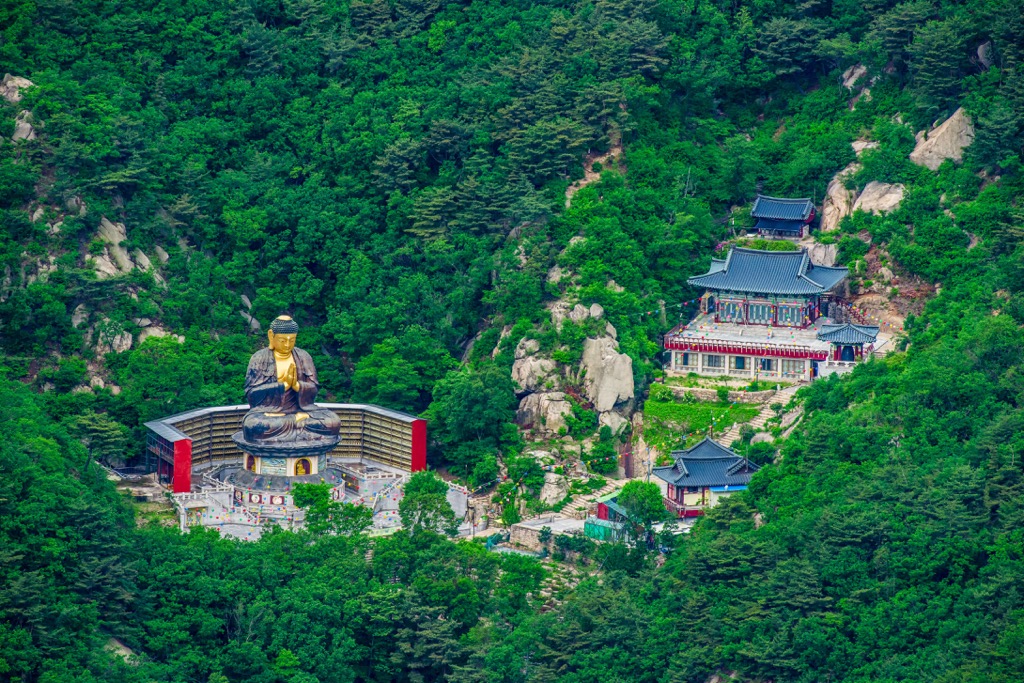
These are the best hiking trails and areas to explore in Bukhansan National Park:
The Bukhansanseong Course is a popular trail drawing visitors to the park’s highest peak. While the route is manageable for most, the last stretch before the summit steepens significantly, so it’s best to be prepared for a bit of a challenge.
Ascending along the trail presents panoramic vistas of the park and Seoul's cityscape. However, you’ll delight in the best outlooks from Bukhansan’s summit.
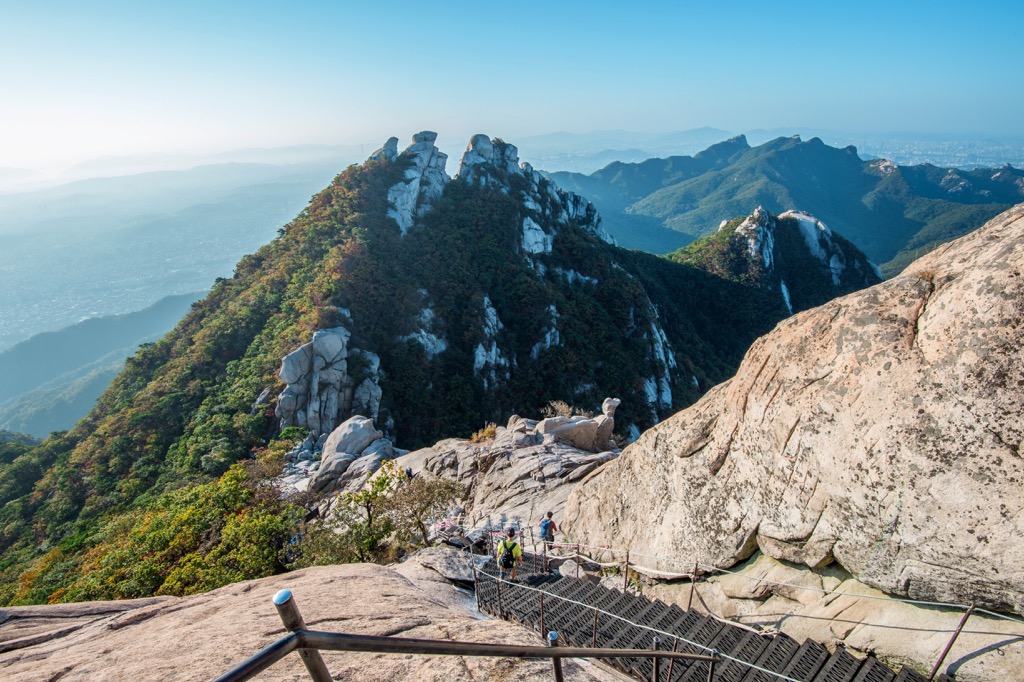
Besides the incredible views, another highlight of the Bukhansanseong Course is passing the historic Bukhansanseong Fortress. Exploring the fortress grounds provides a glimpse into South Korea's rich cultural heritage.
Bukhansan National Park’s second-highest peak is reserved solely for avid alpinists. Due to Insu-bong’s sheer granite cliffs, most of this trail entails scrambling and technical rock climbing.
Avoid hiking in inclement conditions, and ensure you’re equipped with the necessary climbing equipment, such as ascenders, ropes, and helmets.
The best time to climb is during the week, as climbing teams scale this mountain in droves on weekends. Once you’ve reached the summit, you’ll overlook South Korea’s natural beauty of ripping granite peaks and Seoul’s electrifying cityscape.
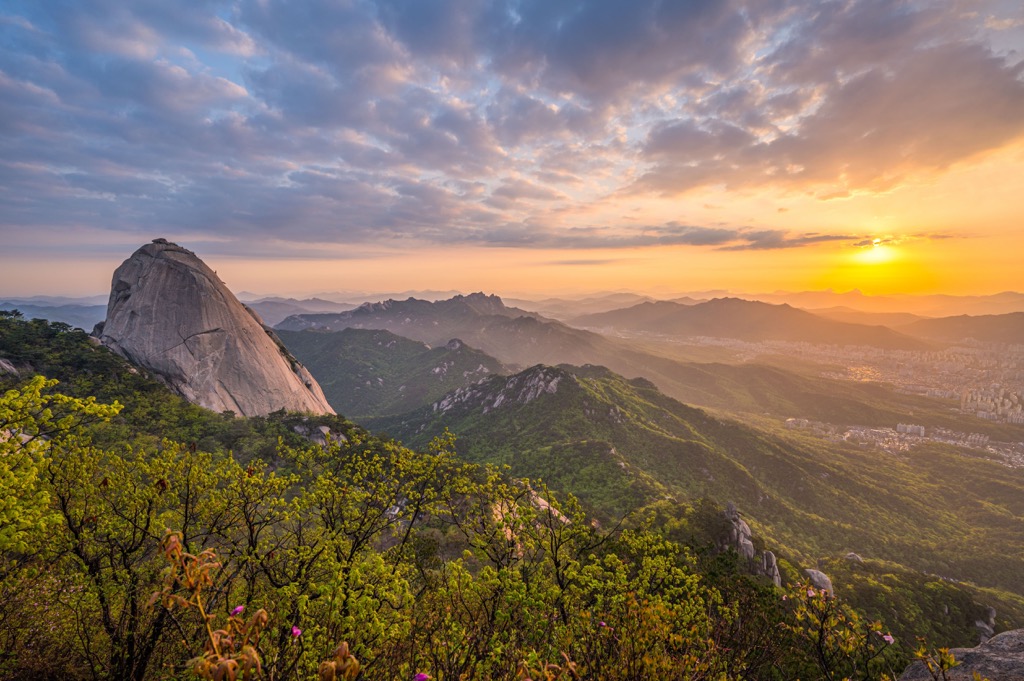
If you prefer a more relaxed option, the Uiryeong Trail (우이령길) offers a gentle and tranquil path through a conservation area. The lush 7 km (4.3 mi) trail affords generous views of towering peaks and valleys, and you’ll encounter luscious greenery and gurgling streams. Visitor access is limited to safeguard this pristine route's ecological integrity.
While traversing the Uiryeong Trail, you will also witness traces of historical significance dating back to the Korean War. Once serving as a road connecting Seoul to Ui-dong (우이동) and Gyohyeon-ri (교현리), the trail features remnants of anti-tank obstacles strategically placed to prevent the advancement of North Korean tanks towards Seoul. These military installations, now preserved along the closed-off road, stand as a testament to the area's past.
For the most dramatic views overlooking the granite spires of Bukhansan National Park, hike the northernmost hill of Dobongsan (도봉산). While climbing this hill, you’ll pass several old temples, waterfalls, and rocky ridges, with an ever-changing viewpoint over the landscape.
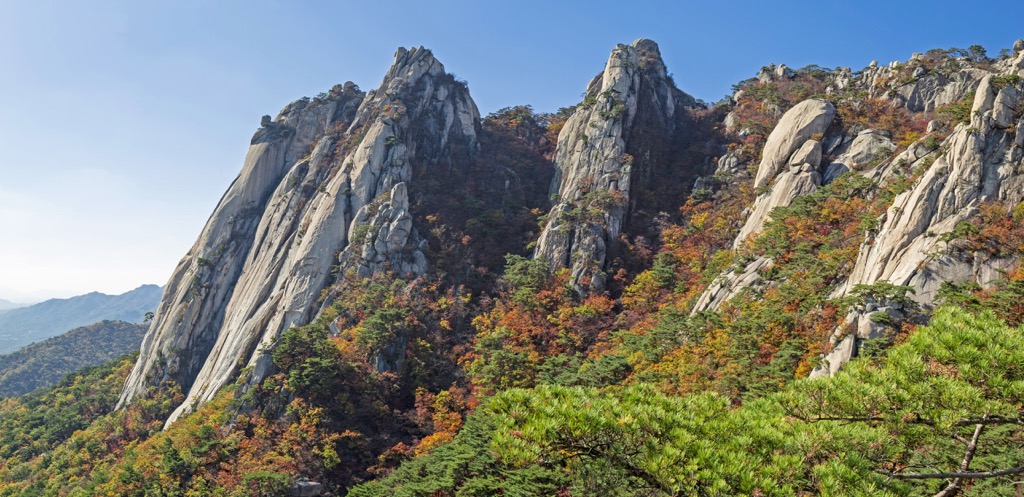
A bubbling stream leads you to several small cascades before you reach Cheonchuksa Temple. A countless array of Buddhist statues greet you upon arrival, with enchanting outlooks onto the rocky mountainscapes.
Continuing, you’ll progress up a series of steps. Most of the path is sheltered forest, but you’ll scramble granite ridgelines at the top to reach Dobongsan. You will have an excellent vantage point from the mountaintop to admire the sharp peaks and rocky formations that embellish the skyline ahead.
Hike the 3.5 km (2.2 mi) Wontongsa Temple Trail for cultural appreciation amongst splendid nature. Similar to other paths in Bukhansan National Park, this trail includes steep sections for climbing.
Besides the peaceful environment of dense, evergreen forests, the trail’s highlight is an ancient temple set at 443 meters (1,454 ft). This historic Buddhist temple, which dates back to the 9th century, serves as a spiritual haven amidst the rugged landscapes of the park. Revel in this mountainside temple's blissful calm and quiet, and admire the glorious views from the cliffside pagodas.
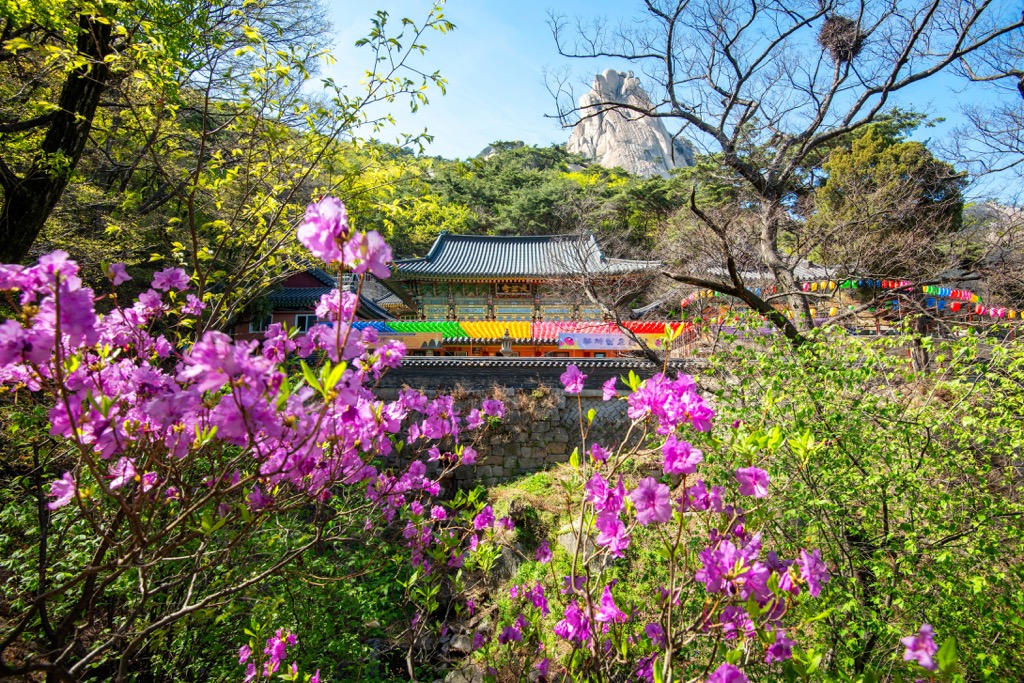
One of Bukhansan National Park’s most popular trails for its relatively easy terrain, you’ll encounter forests, wildlife, and beautiful views on this path. Situated in the south, near the park’s entrance, Bogukmun Trail is easily accessible and a great introductory route into Seoul’s mountainous backyard.
Swarms of oak trees line the path to the park’s interior, and you’ll feel a world away from bustling Seoul within minutes. Honking cars are soon replaced with a melody of chirping birds, flowing streams, and rustling of leaves. The higher you climb, the closer you feel to nature as you look out over Seoul’s cityscape.

The best place to stay to access Bukhansan National Park is in Seoul. Due to South Korea’s small size and modern transport, you can easily stay anywhere in the country and take a day trip to Bukhansan National Park’s granite peaks. The next best place to stay would be in Busan (부산시), South Korea’s second-most visited city.
Seoul is a dynamic city that seamlessly merges traditional culture with modernity. With its impressive skyline, ancient palaces, energetic atmosphere, and welcoming locals, Seoul is a city that never fails to leave a lasting impression. Here are the top things to do when visiting Seoul:
For those who can’t get enough of a good view, visit the N Seoul Tower located atop Namsan (남산). The tower stands at 262 meters (860 ft) and offers breathtaking vistas of Seoul's skyline, especially during sunset and nighttime. You can also enjoy attractions such as the observatory deck, revolving restaurant, and the Locks of Love, where couples attach padlocks to symbolize their love.
To admire Seoul’s history and culture, head to Changdeokgung Palace (창덕궁), located right in the heart of the city. A magnificent UNESCO World Heritage site, it offers a captivating glimpse into Korea's rich history and traditional architecture. Don't miss the Secret Garden, a breathtaking oasis of ponds, pavilions, and centuries-old trees, perfect for a tranquil stroll.

Food lovers will find Seoul to be a paradise of culinary delights. The city's vibrant street food scene offers popular dishes like bibimbap (a mixed rice bowl), bulgogi (marinated grilled beef), and Korean barbecue. Traditional markets like Gwangjang Market (광장시장) and Namdaemun Market (남대문시장) are perfect places to sample these delectable local specialties.
Due to South Korea’s small size and interconnected transport system, you can travel from coastal Busan to Seoul in under 2 hours. So if you’re seeking stunning beaches, delicious seafood, a warmer climate, and a more relaxed pace than Seoul, charming Busan should be on your itinerary. Here’s what to see and do in Busan:
Haeundae Beach (해운대해수욕장) is Busan’s most renowned shoreline for good reason. Stretching for nearly 1.5 km (1 mi), it attracts both locals and tourists with its soft golden sand, clear blue waters, and vibrant atmosphere. You can enjoy various beachfront amenities, restaurants, and attractions alongside the ocean.
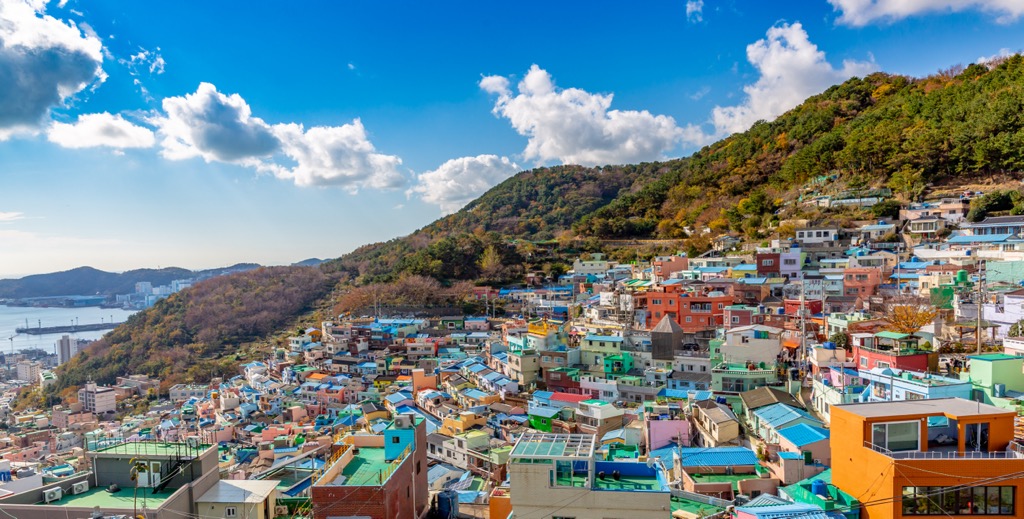
Another much-loved attraction is Diamond Tower (다이아몬드타워), a prominent landmark and observation tower that offers breathtaking panoramic views of the city and surrounding areas. Standing at approximately 120 meters (394 ft), its observation deck provides a stunning vantage point to admire the cityscape, especially during sunset when the skyline is bathed in a warm, golden glow.
Finally, as South Korea's largest seafood market, Jagalchi Market (자갈치시장) is a sensory delight. Explore the bustling stalls filled with fresh fish, shellfish, and other seafood delicacies. You can even select your preferred seafood and prepare it on-site at one of the market's many restaurants.
A few different transportation options are available to reach Bukhansan National Park from Seoul. You can either take public transportation or use a taxi.
If you’re using the metro, take the Seoul Subway Line 3 and get off at Gupabal Station (Exit 1 or 2). From there, board the 34, 704, or 8772 bus and alight at Bukhansanseong Fortress, and enter via the Bukhansanseong Park Information Center.
To access the park from the southern entrance via the Jeongneung Park Information Center, disembark at Girem Station (Exit 3) on Line 4, take bus 110B or 143 to the last stop, and walk to the entrance.
The northernmost entry point is the Dobong Park Information Center. The closest metro is Dobongsan Station on Line 1 or 7 (Exit 1), and you’ll walk 20 minutes to the entrance.
Alternatively, you can take a taxi to reach Bukhansan National Park.
Explore Bukhansan National Park with the PeakVisor 3D Map and identify its summits.

